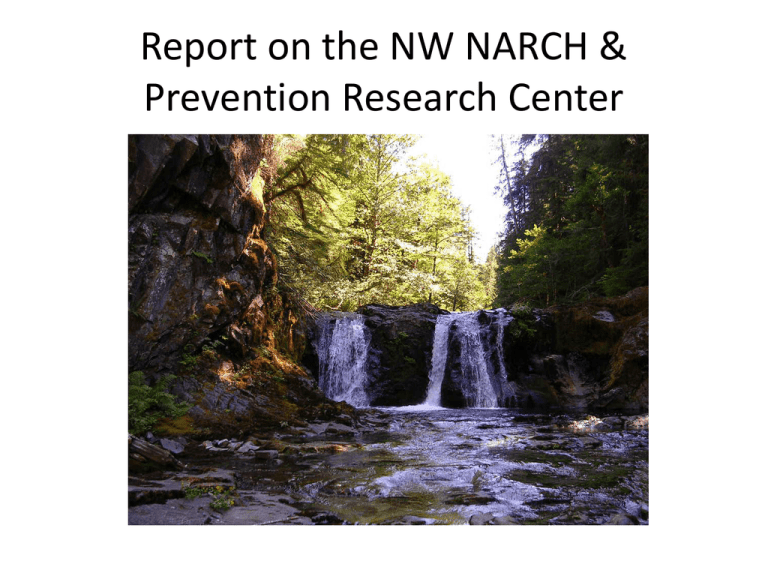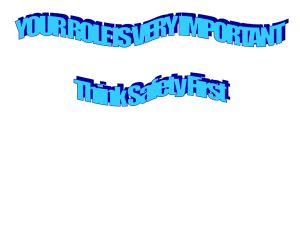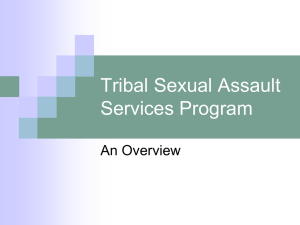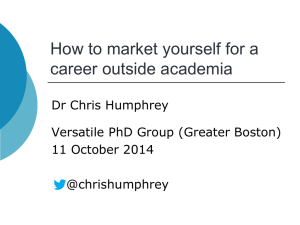
Report on the NW NARCH &
Prevention Research Center
NARCH programs overview
• NARCH scholarship program
–
–
–
–
–
Faculty (post-doctoral level trainees)
Fellow (Master and Doctoral level trainees)
Scholar (NPAIHB employees)
Intern (practical research experience for students)
Accomplishments over a decade presented
• NARCH Summer Research Training Institute
– Established 1995
– Three-week intensive research training program
– Impact evaluation presented
Current trainees supported by NARCH
Trainee
Tribe
University
Program
Expected
completion
MT
Choctaw
Portland State
Sociology PhD
2014
VG
Blackfeet
U Montana
Cell Biology PhD
2014
JC
Turtle Mountain
U Minnesota
Epi MPH
2013
TA-R
Spokane
U Washington
Epi MPH
2014
AS
Navajo
U Colorado
Epi MPH
2013
KJ
Choctaw
U Mass
Med Anthropology PhD
2015
SL-J
Tolowa
Portland State
Environmental Health MS
2014
ST
Lakota/Jemez
OHSU
Epi/Biostatistics MPH
2014
JB
Tlingit
U Alaska
Epi MPH
2015
MW
Navajo
U North Dakota
Psychology MA
2014
BW
S Cheyenne
Portland State
Health Promotion MPH
12/2012 completed
CBP
Lakota
Portland State
Health Promotion MPH
2014
TC
Siletz
Marylhurst
Health Organization MA
2014
TL
Lummi
U North Carolina
Public Health DrPH
2014
LG
Blackfeet
Marylhurst
Health Management BA
2014
EV
Cherokee
OHSU
Informatics certificate
2014
NARCH recipient characteristics
Self-reported role in NW NARCH program and highest level of education completed.
Total respondents (n=64)
Education Status
Faculty
Fellow
Scholar
Intern
0 (0%)
0 (0%)
1 (50%)
1 (50%)
0 (0%)
2 (15%)
7 (54%)
4 (31%)
0 (0%)
16 (48%)
14 (42%)
3 (9%)
3 (19%)
7 (44%)
5 (31%)
1 (6%)
3
25
27
9
2 year college degree
4 year college degree
Masters’ degree
Doctoral degree
Total
NARCH recipient presenting her PhD
dissertation
Presentations since enrollment in the NW
NARCH program
Please list how many of each type of presentation you have conducted since enrollment in the NW NARCH
program. Total respondents (n=64)
Faculty
Fellow
Scholar
Intern
Total
28 (9%)
108 (36%)
138 (46%)
27 (9%)
301
44 (18%)
77 (31%)
107 (43%)
21 (8%)
249
Abstract presentation at
national conference
30 (20%)
26 (17%)
85 (56%)
10 (7%)
151
Posters presentation at
national conference
12 (11%)
21 (20%)
51 (49%)
21 (20%)
105
114
232
381
79
806
Local community setting;
workshops; health fairs
Tribal Health Board; IRB; tribal
or regional conference or
workshop
Total
NARCH recipient presenting her work
Publications since enrollment in the NW
NARCH program
Please list how many of each type of presentation you have conducted since enrollment in the NW NARCH program.
Total respondents (n=64)
Faculty
Fellow
Scholar
Intern
Total
Book chapters; co-author of article
published in peer reviewed journal
11 (24%)
18 (39%)
14 (30%)
3 (7%)
46
First or second author of article
published in peer reviewed journal
8 (13%)
19 (31%)
30 (49%)
4 (7%)
61
Non-peer reviewed manuscripts;
article in a newsletter; fliers;
educational or program brochure
6 (2%)
74 (24%)
187 (60%)
46 (15%)
313
25
111
231
53
420
Total
NARCH recipient taking a break during the
Summer Institute
Grants awarded since enrollment in the NW
NARCH program
Please list the total amount of each type of grant you have received since enrolling in the NW NARCH.
Total respondents (n=62)
Faculty
Fellow
Scholar
Intern
Total
Funded grants from local
foundations
0 (0%)
8 (33%)
14 (58%)
2 (8%)
24
Funded grants from national or
international foundations
2 (13%)
4 (27%)
9 (60%)
0 (0%)
15
Funded multi-year; entry level
federal grant
2 (20%)
2 (20%)
6 (60%)
0 (0%)
10
Funded as a co-investigator on
federal grant
10 (32%)
1 (3%)
20 (65%)
0 (0%)
31
Funded as principal investigator on
federal grant
2 (20%)
1 (10%)
7 (70%)
0 (0%)
10
16
16
56
2
90
Total
2008 Summer Research Training Institute for
American Indian and Alaska Native Health
Professionals Evaluation Results
Center for Healthy Communities
OHSU, CDC Prevention Research Center
Thomas M. Becker, MD, PhD (Director) and William Lambert, PhD (Associate Director)
Mission
To address the health promotion and chronic disease prevention needs of tribal
and other underserved communities through community-based participatory
research, and through training, dissemination, and evaluation activities.
Partners
Center for Health Communities Staff: Thomas Becker (Director), Tosha Zaback (Program Manager), Nichole Hildebrandt
(Project Manager), Jessica Kennedy (Project Manager), William Lambert (Associate Director)
Center Projects
• Noise-Induced Hearing Loss Prevention Project
• The Comparative Effectiveness of Telemedicine to Detect
Diabetic Retinopathy Project
• Healthy & Empowered Youth (HEY) Project
• Colorectal Cancer Screening Toolkit
• Northwest Portland Area Indian Health Board
•Oregon Department of Human Services
• OHSU Hearing Research Center
• Indian Health Service
• Oregon Rural Practice-based Research Network
• Native American Youth and Family Services
• Devers Eye Institute
OHSU, Prevention Research Center
Center for Healthy Communities
3181 SW Sam Jackson Park Road, CB-669
Portland, OR 97239
Phone: 503.494.1126
Fax: 503.494.7536
Email: oregonprc@ohsu.edu
www.oregonprc.org
*The Center for Healthy Communities at OHSU is a CDC-funded Prevention Research Center (U48 DP001937).
Center for Healthy Communities:
Listen for Life Campaign
Using Filmmaking to
Engage
Native
American
Youth in
Reproductive
Health
Improvement
DEVELOP YOUTH
UTILIZE COMMUNITY
ACTIVITIES
STRENGTHS
• Tribal Council
Tribal
Leaders
• Culture Committee
• Advisory Board
Tribal Health
• Traditional knowledge
• Commitment to
wellness
Services
• Respect for elders
• School Board
• Native pride
TEACH
• Native STAND
Tribal
School
• Film-making and
photography
• Storytelling
PRODUCE VIDEOS
• Oral histories
DISSEMINATION
• Media Literacy
• Community events
• Native language
• Tribal Council meetings
• Wellness Center Meetings
• YouTube and Facebook
• Short films
• Billboards
• Posters
HEY project results
•
•
•
•
•
Successful delivery of 28 units of Native STAND
curriculum
Youth are more aware of their bodies and Native
STAND allowed them to understand safe sex,
pregnancy, and STDs
Realize “it could happen to them” and state
that they are motivated to take precautions
Positive shifts in KAB on pre- post-tests
Over 50 films produced and many posted to
YouTube
Youth are presenting their work to others: Tribal
Council, film events, and national conferences
H.E.Y. youth show a basic understanding of “media
literacy”
Think about underlying messages and
recognize technical strategies
Their new technical skills are reported to
increase feelings of positive identity
Colorectal
Cancer
Screening
Toolkit
Giant Colon






